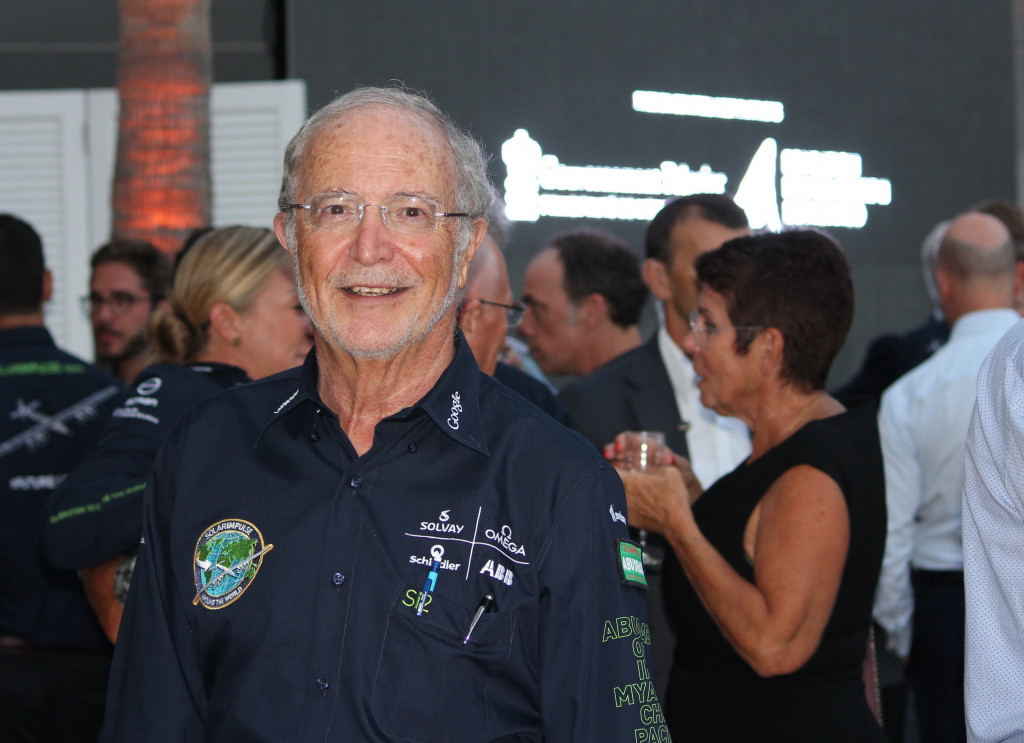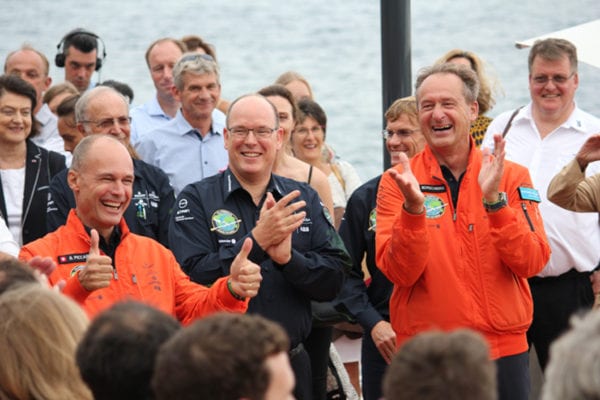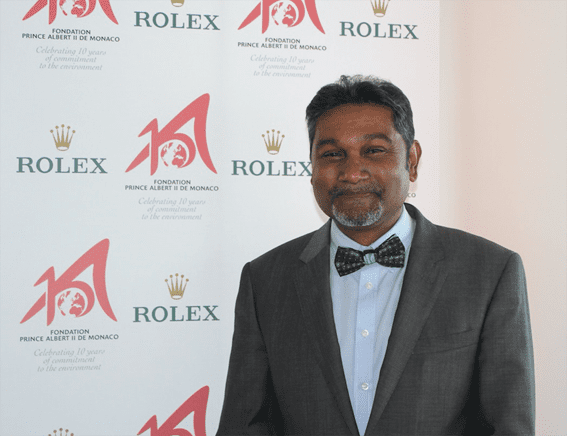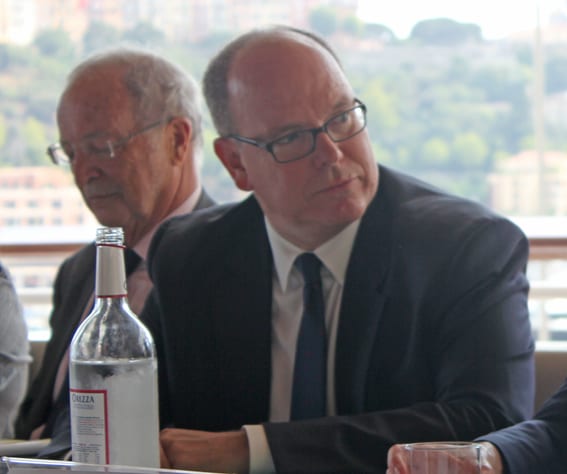
HE Bernard Fautrier, CEO and Vice-President of the Prince Albert II of Monaco Foundation, at Solar Impulse 2 reception July 29, 2016
Eco-Warrior. Green Prince. These are just a few of the nicknames given by the press to HSH Prince Albert II, a champion of the environmental cause since well before his ascension in 2005, and certainly before climate change became a global discussion or a public threat greater than terrorism.
A kindred spirit of his great-great grandfather, oceanographer Prince Albert I, who, incidentally, bestowed the constitution of Monaco in 1911, Prince Albert II declared in his speech after he inherited the throne, “This collective will to preserve the environment must be one of the contributions of our country to the international community. I wish, of course, that our expertise in this domain be of benefit to us all through the various cooperation projects with other countries, including those in the Mediterranean zone.”
He made his pledge in earnest. In April 2006, the year that marked the 100th anniversary of a voyage for scientific exploration to the North Pole led by Prince Albert I, to study marine life and the movement of glaciers, Albert II followed his ancestor’s icy footsteps, to witness firsthand the impact of global warming, making him the first head of state in office to reach the North Pole: “We could see the changes … great imbalances in biodiversity, emblematic species that were already becoming disturbed, unpleasant things on the ice, elements of pollution.”
The experience prompted the sovereign to set up an organisation, Fondation Prince Albert II de Monaco (FPA2), on June 30 of that same year, which would not only be a personal commitment, he is acting president, but also a force / a means to unite people in their resolve to find better solutions for the state of the planet.
Fast-forward a decade to the day, commemorating FPA2’s tenth anniversary, at a press conference at the Yacht Club de Monaco, at which the Prince stated, “I’m so happy that the Foundation is experiencing such a development and that we’ve been able to move on these issues with others in a coordinated way and a efficient way. There’s still so much we have to do but we can’t do it alone.”
In the audience amongst the reporters was Bertrand Piccard, who has just made history by flying Solar Impulse 2 across the Atlantic, for a total of 71 hours and 8 minutes, without a drop of fuel, before landing in Seville, Spain on June 23. Although the idea of a solar-powered airplane to promote clean technologies was born out of a shared vision between Piccard, initiator and chairman, and André Borschberg co-founder and CEO, in Switzerland twelve years ago, Prince Albert showed his support for the initiative by hosting the Mission Control Centre on Monegasque territory.

The Prince also gives support to Pope Francis, who in 2015 focused on the issue of global warming in his encyclical Laudato Si, in which Albert wrote the postface commending the head of the Catholic Church’s discourse, “I’m sure that reading this will help us to jointly address this great challenge of our century” (you can download an English version free at laudatosi.com), while citing “the ecological crisis is a call for a profound inner conversion”.
Since its inception, FPA2 has facilitated over 380 projects and has received thousands of demands for funds, for partnerships, and for specifically focused issues. “Some we turn away because they don’t fit into our strategies or urgencies,” the 58-year-old monarch explained, “but I think this shows we are on the right path and going in the right direction.”
Bernard Fautrier: the heart of PAF2
Another name that repeatedly merits mention in any conversation about Monaco’s plan for environmental protection and sustainable development: His Excellence Bernard Fautrier, PFA2’s CEO and Vice-President.
It’s no coincidence that HE Fautrier would be appointed as Albert’s right hand man to oversee the Foundation’s mission – to establish partnerships, raise public awareness and encourage initiatives through grants, while highlighting “the impact of human activities on the natural environment” – as he comes with an extensive career in the environmental sector, particularly working with the government, long before it was cool to be an environmentalist. “I was with Prince Albert at the press conference, a few months after he took the throne, when he announced the creation of the environmental Fondation Prince Albert II de Monaco,” the highly likable Fautrier told me from his office at FPA2’s headquarters, on Boulevard de Suisse. “After, when the journalists had left, we were walking together and he said, ‘Well, now I need to find someone to get it started. How about you?’”
HE Fautrier, like many of the 15-strong FPA2 team in Monaco, has been on board since day one. And there are, as of April 2016, eight FPA2 foreign offices, run by volunteers, in Canada, France, Italy, Germany, Singapore, the US, the UK and, most recently, Spain, which represent the organisation’s appeal to promote renewable energies, safeguard biodiversity, manage water resources and combat deforestation. “Although the presidents meet only once or twice a year, we are a coordinated effort with the scientific community,” Fautrier, who has been instrumental in finding the right people to embody the Foundation, added.
FPA2 prioritises three regions, the Mediterranean basin, Polar Regions and, as defined by the UN, the world’s least developed countries, like those in Sahelian Africa. “Our main objective is to raise awareness to the public, businesses and government about the environmental issue and sustainability.”
HE Faurtrier admitted things have changed in the ten years since the Foundation was created. “I’ve followed the environmental issue for 35 years and, in the beginning, nobody really knew what it was. Maybe five percent of the population thought there was a problem, and businesses were defiant to develop a green plan.”
These days he’s “not obsessed” with the statistics of believers versus non-believers in the biggest world crisis of the century. What counts for Fautrier is that today governments are better informed about incontestable scientific evidence – for example, a 90 percent diminished shark species or near extinct red tuna or icebergs disappearing – and they can take the necessary measures for the future of our planet. As well, the public, more and more, is starting to see how this affects lives on a daily basis, and on the corporate side, green is seen as “good business”, with eco-friendly earnings outweighing polluting.
“We are in a situation of quasi-extinction of certain species in the Mediterranean due to overfishing and absence of control. Governments have reacted by implementing fishing quotas and teaching fishermen how to do this intelligently, while maintaining their profession for the future. As a result, years later, species have stabilised.”
Educating consumers and professionals in this field has been equally imperative in protecting endangered marine species and since October 2013, FPA2 has been regionally coordinating The Mr Goodfish campaign, an initiative that stems from a simple observation – too many fish species are over-fished and endangered while many others are unknown but abundant and delicious – and aims provide consumers with a list of alternative fish options. In Monaco, the Michelin star Le Vistamar and Les Thermes Marin Monte-Carlo both support this movement to promote responsible consumption of seafood.
Green thinking partners and platforms
Since its inception in 2006, FPA2 continues to develop an impressive list of Project Partners – from the globally-recognised WWF to the local Parc National du Mercantour, some 40 kilometres from Monaco – as well as Institutional Partners, including National Geographic, The Climate Group and The Tiffany & Co, and has invested €35 million in projects.
And while the FPA2’s administrative costs are covered by revenue on its capital and the government, projects are usually financed 100 percent by donations. With the recent “Save the Seahorses” campaign, and its projected budget of €80,000 to repopulate the Larvotto Marine Reserve, the Foundation tried a modern approach. “We decided to test crowdfunding,” Fautrier said. “This was a first and it was an enormous success.” For as little as €15, donors receive an e-certificate of their adopted seahorse. Around 70 of the small, curtailed fish will be introduced along Monaco’s coastline this year, and once acclimatised, baby “hippocampus” will be reproduced within three weeks.
FPA2 used Monaco Crowdfunding, the country’s first participatory finance platform, founded in 2015 by Sébastien Prat and Frédérik Farsetti to promote projects from humanitarian associations, cultural or heritage protection of the principality.
FPA2 also awards three annual prizes in the fields of biodiversity, climate change and water. Speaking to Monaco Life, South African-based Dhesigen Naidoo, CEO of the Water Research Commission, winner of this year’s FPA2 access to water honour, said, “One of the powerful things about the Monaco Foundation is that it’s one of the few in this domain around the world that isn’t recognised as having a corporatised agenda, so it’s a genuinely neutral voice pushing climate change and the green agenda in the world that is really well respected.” He added, “This recognition helps our organisation to be able get our own messages out around the importance of research and innovation to make a fundamental change to the lives of people and the planet.”

His Serene Highness also rewards green thinkers annually at CleanEquity Monaco, the world’s leading invitation-only emerging cleantech conference held every March, an event that Prince Albert conceived with Mungo Park of Innovator Capital in 2007. During the closing ceremony, the Prince, who in 2012 adapted the Smart City project connecting technology to public services, hands out the awards for Excellence in the fields of Environmental Research, Technology Development and Technology Commercialisation.
Seth Grae, CEO of Lightbridge Corporation, winner of the 2016 Excellence in the Field of Environmental Research, told Monaco Life, “The investor groups that are at the conference are world class. The 27 companies presenting were clearly very carefully selected and were all of high quality. Part of the nice experience of being here is to be able to meet with European and Asian investors and to hear from the other companies and, unlike other conferences, not to be inundated with service providers.”
It cannot be overlooked that Prince Albert himself has been on the receiving end of ecological accolades. A few weeks after his participation at the historic Paris COP21 in November last year (despite researchers now claiming the measures pledged at the summit will still see a 2.6°C to 3.1°C temperature rise by the end of this century, not “well below 2°C, as forecasted), Prince Albert, with HE Fautrier, travelled to New York where he was presented with the 2015 Global Advocate Award for advocating biodiversity and climate change research by UN secretary general, Ban Ki-moon. President Bill Clinton received the award in 2006, the same year FPA2 launched. Earlier in 2015, Albert was presented with the “Oscars for the ocean”, the Award for Excellence in National Stewardship at the 2015 Peter Benchley Ocean Awards in May.
Monaco’s sustainable agenda
So absolutely, the Prince is actively devoted to his promise to “encourage more environmentally-friendly behaviour” but Monaco itself cannot fix the global problem of climate change. The state can do its part to reduce emissions by 30 percent by 2030 but, as Fautrier pointed out, “it doesn’t have a lot to play with”, compared to Russia, for example, where if a factory is closed, it could cut the country’s pollutants by 20 to 40 percent.
“Monaco has three carbon components to work with,” Fautrier explained. “First, and not so complicated, electric heating and air-conditioning in buildings, for which there is energy alternatives. Second, and more complicated, is waste management. We need to reduce our waste and also, instead of burning it, find a different treatment that will reduce emissions. And, the last piece of the pie, traffic. This is very, very complicated.”
The second smallest state in the world is one of the most densely populated, and during the workweek, the number swells from 32,000 to 55,000 with commuters. Monaco’s public transport CAM, using buses that meet advanced environmental performance standards (Energy Efficiency Verification label, or EEV), has seen an increase of 20 percent since 2009, thanks to improved frequencies and accessibility. Mobee electric car sharing (you can park for free with electric cars) and electric bikes programs have been launched, and the Prince drives a Tesla, while the palace has a fleet of Priuses.
Then there’s the not so green elephant in the room, the iconic Monaco Grand Prix, the antithesis of a green agenda. “People are right to think that Formula One is not a good symbol for Monaco,” Fautrier, who’s in contact with the Prince on a daily basis, openly stated. “Yet this is an institution for Monaco and economically favourable.”
Fautrier calculated that if you took all the royalties paid to the principality for the rights to use images during the Grand Prix, it would equal the state budget. He added, “For twenty years, journalists have been asking the question, usually ten minutes into an interview, ‘How can you be a defender of the environment and yet host the Grand Prix?’
The question is met with a question in return. “Do you know which day of the year Monaco produces the least amount of air pollution?”
Still, “we have to be intelligent,” Fautrier continued. “This is why Monaco hosted the first ever ePrix race in 2015. Formula E delivers a different message, that today we have alternatives that can be as spectacular while promoting clean mobility.”
The Foundation, along with ONE DROP, the non-profit created by Cirque du Soleil Founder Guy Laliberté in 2007, has partnered with the all-electric FIA Formula E, and photos of the Prince at the Paris ePrix on April 23 were not just calculated photo ops for People Magazine. He is investing in a “société décarbonée”, without the crashes, fires and pollutants that typically embrace Formula One races.
This Eco Warrior, this Green Prince, is driving his personal commitment on the road to sustainability towards a better planet earth for our children.
And, recognising the dedication of HE Fautrier and the Prince Albert II Foundation,
I’m confident the future is bright … and green.
Follow FPA2’s tenth anniversary events at fpa2.com
Article first published August 1, 2016
